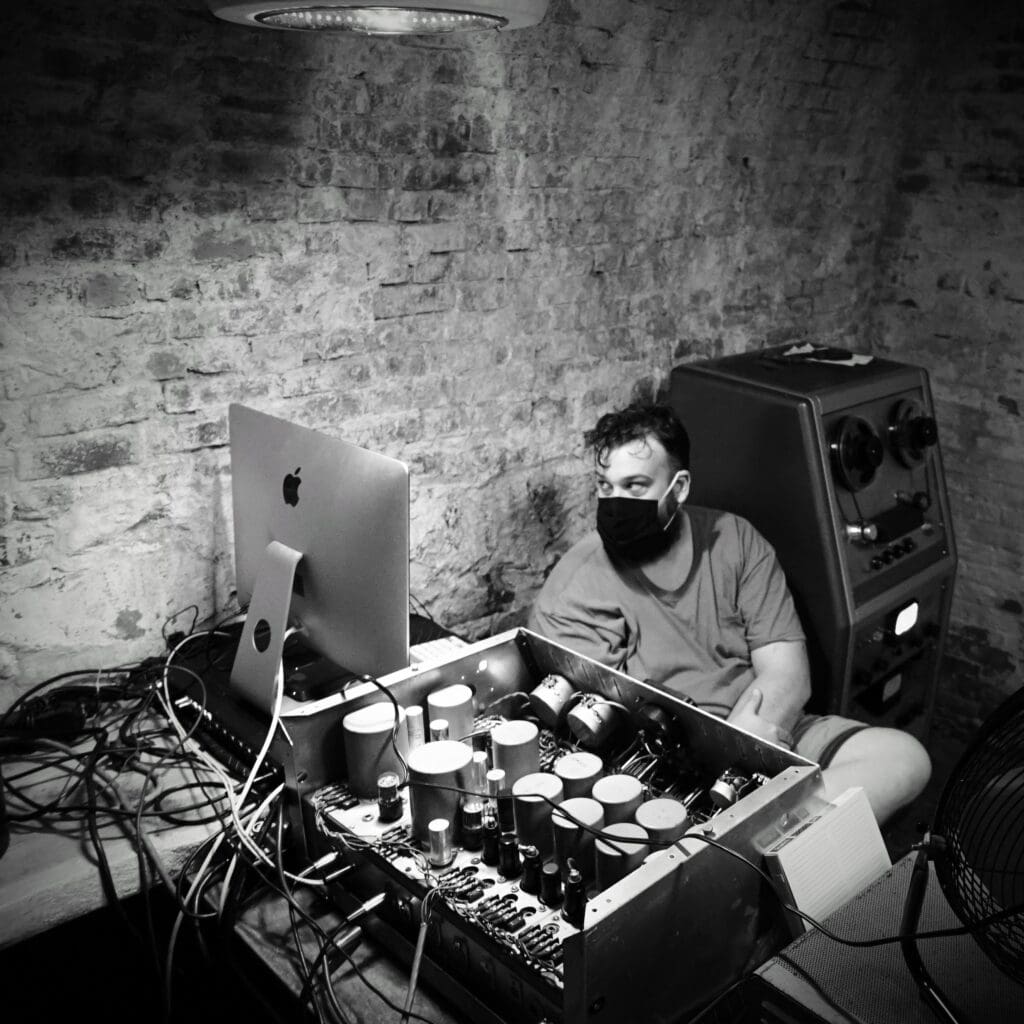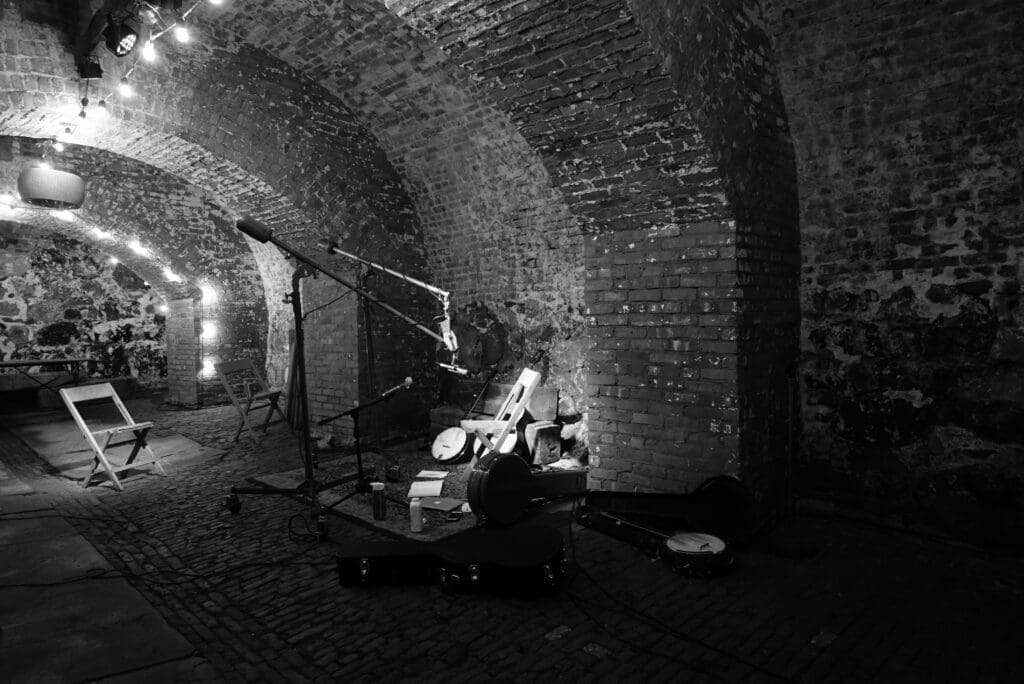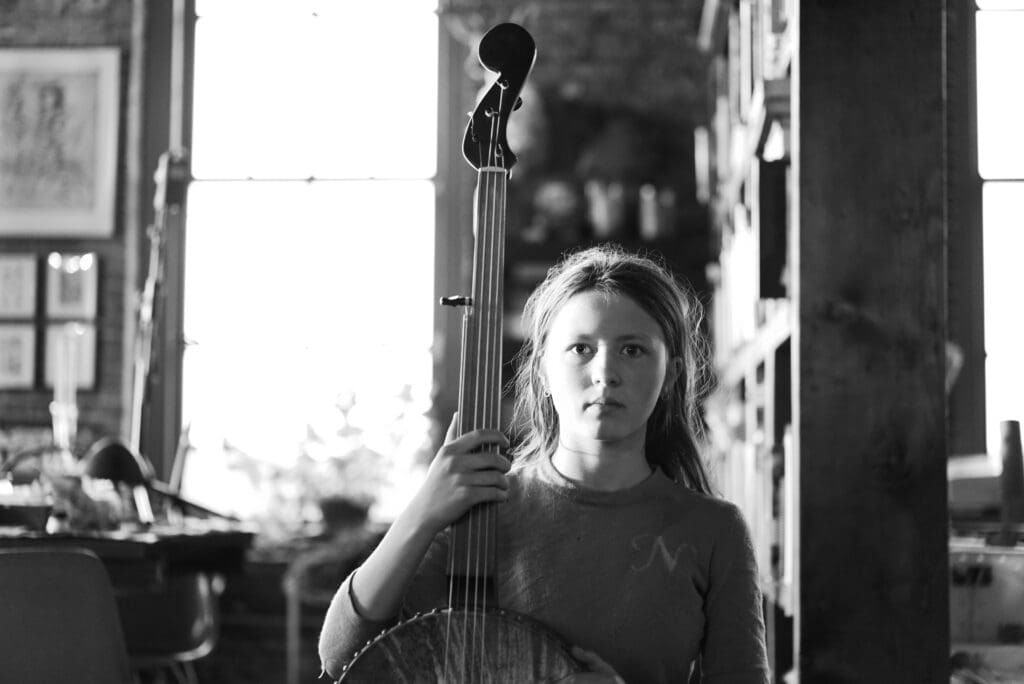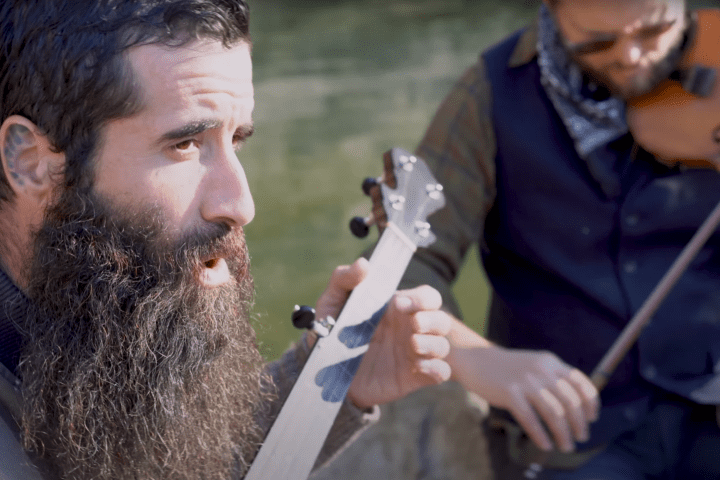The story is unbelievable before you even hit “play” on the music: Nora Brown, a 16 year old obsessed with old time music records a vocal-and-clawhammer banjo album using vintage gear in the tunnels thirty feet below her Brooklyn home. But then you actually listen to Sidetrack My Engine (website, Bandcamp link), the young musician’s second album and it’s somehow even harder to fathom. Brown, still in the 10th grade, is making some of the most interesting and haunting traditional music we’ve heard.
I wanted to hear how this impossibly talented musician came to be… and how someone so young could become obsessed with music so old. So, one weekday after her school let out, I reached out to Brown via Zoom to hear about the making of Sidetrack. It’s a tale unlike any I’ve heard before from a musician I can’t wait to hear more from…
Fretboard Journal: Where are you? I see the street and train in the background. You’re obviously somewhere near New York City.
Nora Brown: I am. I’m in Crown Heights, Brooklyn.
FJ: This is probably the one interview I’ve done in recent memory where I had to wait for the subject to come home from school. Can you walk me through how you found old time music at such an early age?
Nora Brown: I started playing old time music when I was six. I was playing the ukulele and learning from a man named Shlomo Pestcoe, who was an excellent musician and scholar of old time and traditional American music. I started learning from him. It was a little bit random, through a friend of a friend. We were looking for a ukulele teacher and they said, You should go to him, our kids go there…
Shlomo only taught old time music. At that age, I didn’t really know what that was and I didn’t know that what I was learning was special or unique. I just thought it was “music.” I’ve continued playing it since then.
FJ: And why the uke?
NB: I was six and I don’t remember much about why I wanted to play ukulele, but I know we had some family friends that played. I guess my parents were like, “Do you want to learn an instrument? How about the ukulele?”
FJ: I know he passed away a while back. Was he able to teach you the fundamentals of traditional banjo playing? Or did that come later?
NB: That came after, actually. Just before he died, we started to learn banjo together and we would learn some chords … just a little bit around the banjo. But I hadn’t really started learning the style that I play today, clawhammer, until after he passed and I started learning from some other teachers.
FJ: Was there a moment or a musician that guided you to clawhammer banjo?
NB: No. Starting off in the genre, I didn’t really need any guidance to keep me playing. I started learning these old time songs on the ukulele and Shlomo would have these hootenanny’s or recitals where we would all play a song that we learned recently. Sometimes you would like collaborate with other students. As I got older, I would play by myself.
That introduced me to performing a little bit and normalized it a little bit. You learn music and then you share it… and that’s how it goes. Even after he passed away, I kept doing that.
FJ: Is there a strong community in New York City for this kind of music?
NB: Yeah, definitely. The Jalopy Theater is an amazing folk music venue where I’ve met a lot of people. It’s a really awesome community of folks and it doesn’t just stick to old time. Even though it may seem surprising, there are definitely a lot of people here who play it.
FJ: What does your music listening consumption look like? Is it mostly old time music or are you all over the map like most 16 year olds?
NB: Music that I just listen to on a daily basis definitely covers all genres. But that includes old time.
FJ: The cool thing about traditional music is that you get to play music historian, too. I’m sure you’re constantly seeking out and finding new material that you hadn’t heard before.
NB: For sure. That’s one of the awesome things about the music; you find a really great song and you’re like, “Oh my God… this is the best thing I could have ever learned… I love the song so much.” You [then] discover something else and you just get that feeling again. It’s very cool to not only see how much recorded music there is, but different versions of songs that maybe you know one version of. For example, “Shady Grove,” that’s a pretty common well-known tune, but there are a lot of cool, unique versions of the song that are just played differently… it could be in a different tuning, or could be a slightly different melody. There’s always that curiosity of finding out other things and listening to more stuff.
FJ: So when you went into the studio to record Sidetrack My Engine, what banjos did you take into the studio and how much of this material did you have figured out before you walked in?
NB: Well, I figured out the material before I recorded it, but I wasn’t in a studio. It was actually down below our building in these old lagering tunnels that were used in the mid-1800s for lagering…
FJ: Lagering? Like for beer?
NB: Yeah. Our friend was coming up to the city to record some folks at the Jalopy Theater, and we were like, “Let’s record some things!” It’s been around a year and a bit since I released Cinnamon Tree. He lugged this extremely heavy, beautiful, old equipment – reel-to-reel recording machinery and vintage microphones and all this stuff from back in the day when people were cutting 10-inches. That’s what this record is; it’s a 10-inch EP. I figured out what I was doing before I went in there. Not everything I recorded is on the record. It’s a shorter one because [with] the 10-inch… you can’t fit everything on there.

FJ: I need to hear more about these lager tunnels. Is this your music room? Do you just hang out down there?
NB: No. It’s a little cold down there. My parents are in the cheese aging business and that’s what most of the tunnels are used for… to age cheese. They’re aging and they’re distributors. There’s no cheese making happening, but local farms will ship their young, fresh cheese here. And then they wash it, age it and care for it until it’s ready to be sold. There are some empty tunnels, too, down there. We used to host this monthly concert series called Cave Music, where we’d have musicians come through town and play. Around 60 people could fit in there. Obviously, we stopped doing that because of COVID. It’s very tight room.
But we knew that music sounded good down there. It’s a cool sound. And it’s a little different without all those people in there. All the reverb that’s on the record is completely natural. I made sure to have a disclaimer on [the record] because I would definitely not do that to my recordings [normally]…
That unique architecture combined with the old equipment was definitely a mix that led to some issues, but it also led to a really cool sound that matched what I was looking for, that old field recording, archival music kind of sound.
FJ: What a cool setup. Is this a building that you’ve spent your entire life in?
NB: Not exactly. But, basically, yes. There are two buildings. The building I live in is right next door to the building which has the caves underneath it. So I’ve had access to them my whole life.

FJ: That’s amazing. You didn’t have a long commute. You just had to lug your music gear down some flights of steps?
NB: Well, there’s actually an elevator there, because of the cheese that has to go there. My instruments came down the steps. The [recording] equipment is extremely heavy. That had to be let down the elevator.
FJ: Was it your idea to record a record using this old gear and cutting it to the length of a 10-inch EP?
NB: It just fell into place because Jon [Atkinson], who recorded the music, works at Bigtone Records and Bigtone was coming through town. Otherwise, I probably wouldn’t have recorded anything, because it just wouldn’t have been convenient to do something like this. The 10-inch record was caused by some of the recordings being a little bit messed up; I didn’t know if I wanted to fill a full LP with some of this stuff. There were some complications from the architecture combined with that old equipment, which are both cool in themselves, but maybe weren’t the best match for each other … a more controlled environment would have been better for the equipment.
FJ: What does your banjo quiver look like these days? I know you have a few.
NB: Yeah, I have three main banjos that I use. The one I use the most is a [early 1920s] Gibson “snakehead” banjo. This is pre-trapdoor, an early model of that type of banjo.
That trapdoor function really only started to be used just after manufacturers realized that it was hard to create the model that I have. The rim of the pot I have is actually hollow. It’s a thick wood, but it’s actually hollow inside… and a couple of tone rings are in there, too. I love this instrument very much. It also has a little wider pot, I think 12 1/2″. The neck is not as old as the pot. It was made a couple of years ago by Will Seeders of Seeders Instruments. The original neck was a four-string instrument, so he built a new one for it that was five string. It’s got this beautiful, warm tone and it’s very easy to play. I feel like I could never find a banjo that suited me more.
But I also play a fretless, pre-Civil War replica-style banjo, which my dad made under the instruction of banjo maker Pete Ross. It’s a cool banjo. It’s got those nylon strings that contribute to that warm, mellow tone. And then there’s also my great, great grandfather’s banjo. That’s a small little Luscomb banjo. We redid it a little bit and put a new head on it. The head had a big gash through it when we received it. We also put some nylon strings on it.
I have a fretless nylon string banjo, I have a fretted metal string banjo, and then I also have a fretted nylon string banjo. That allows me to get that sound from the fretless, but also be able to do songs where I can go up the neck.
[On a fretless], some people are very skilled and can tune their banjo to the same spot every time and work it out … but I don’t ever tune to a tuner on my fretless banjo. That’s on me, for sure. I never put my fingers in the same place, precisely. I think that’s probably why I can’t do too much on it. After the seventh, maybe ninth fret on the first string, it’s like, yeah, you want to try to go there. So the other banjo – with the frets – I can play all the way up there and you can still get that fun, clunky tone, fun tone.
FJ: One thing that I really loved about both your albums is that both your banjo technique and your vocals are amazing. You seem to be mining these old songs with emotions far beyond your years. Did you have any vocal training?
NB: Yeah, I have had some vocal training, but I just sang a lot when I played. I do go to a music school and I’m a vocal major and sing every day now during the school year.
FJ: “The Very Day I’m Gone” is heartbreaking. It’s a beautiful song. To use that as an example, can you walk us through the chronology of when you discovered it and how it evolved in your head?
FJ: Sure. This is a great example, because it’s not like I just heard a recording and learned it. There’s a little more to it. My family got this album from Appalshop. Appalshop is a record label based out of Whitesburg, Kentucky. They are known for publishing lots of local artists and it’s a great label if you’re interested in old time music. They published an Addie Graham tribute record [The Very Day I’m Gone: Songs of Addie Graham]. On this album, “The Very Day I’m Gone” was by Anna & Elizabeth, who are a contemporary old time band. I first heard it when I was in the car with my family and we were like, “Oh my God, that’s so beautiful.” The guitar playing is like a heartbeat. I try to mimic it in my playing, too. It’s alternating between these two octave strings. It’s mesmerizing.
We then had [that song] on repeat for at least 10 times in a row. We were on a long road trip and had been deprived of things to do for a long time, so it was amplified a little bit. But I later heard Addie Graham’s actual version of the song off her record, which also can be found on Appalshop. She plays piano on the track and sings it, and she has that same pattern. It has that same rhythm, that mesmerizing kind of heartbeat sound.
I’m playing it on a different instrument than Anna or Addie Graham was, so there’s that. I guess I’m a couple of degrees of separation from the actual version of the song, the source recording. But that heartbeat – that mesmerizing sound – is a real telling quality of this song. It’s very simplistic, technically, on the banjo, which allows for more complexity, musically. I’m not worried about hitting all those right notes or jumping up and all over the neck, getting everything right. I’m only playing two notes for most of the song… that allows for more focus from me as a musician, to just get that sound that I’m looking for.
FJ: So what’s next for you? Do you want to record a longer album that doesn’t have all the variables of the cheese caves?
NB: Yeah. I actually have already recorded another album in St. Ann’s Church, which is church that the Brooklyn Folk Festival is usually held in. We were able to have it for a weekend and just experimented, trying out different spots and singing and playing music. It’s a solo record; a lot of the stuff that I didn’t put on Sidetrack is probably going to be on there… a lot of the stuff that was quieter and more plunky, solo banjo stuff [that] didn’t make it to Sidetrack.
FJ: Are you pretty happy with your trio of banjos or do you have your eyes on other instruments?
NB: I would like another banjo. I struggle a lot with tuning on stage because I’m always tuning to another tuning, that happens a lot. There are a lot of tunings in my repertoire. And I’d like to be able to fit a lot of different songs into my sets, but a lot of times I’m forced to choose between stuff because it’s too tricky to tune back-and-forth between that spot in this amount of time…
FJ: Got it. So would that mean that you’d probably lean towards like a modern built, contemporary built banjo? Would that hold the tunings better?
NB: It’s not necessarily about holding the tunings; it’s more about just having another instrument that’s tuned somewhere else, without [having to] tune the banjo that I was using before. I would like a resonator banjo… that would be very cool… or a trapdoor banjo. But I’d also just like another open back, similar to the one I have that maybe has a little bit of a different sound, but operates the same. Then I could get right into the next song without having to tune all my strings.
FJ: Well, this EP is fantastic. I was blown away by it. Sometimes you listen to remakes of old songs and people have the virtuosity down, but it leaves me a little cold, but you were like a gut punch. You sound like those are your songs, which is amazing.
NB: It was an interesting project. It was very fun to make. I also want to definitely record some stuff [with] more collaborations in the future. It’s a little lonely up on-stage. But thank you.

All photos: Benton Brown


